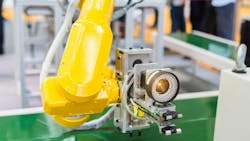Data-driven factories can use computer vision, analytics to improve quality and safety
What you'll learn:
- What once required layers of human review and post-production checks now happens instantly, on the line, allowing teams to act before defects multiply.
- The real power of computer vision lies not only in what it sees but in what it teaches.
- The shift toward a data-driven factory isn’t about replacing human expertise. It’s about amplifying it.
Factories have always had eyes. Decades ago, those eyes belonged to inspectors walking the line with clipboards and flashlights, scanning for the slightest scratch, dent, or deviation. Today, the factory’s eyes are digital, featuring high-resolution cameras, sensors, and vision systems that capture every movement, surface, and signal in real time.
But it’s what those eyes can now see and understand that’s transforming manufacturing. Computer vision, powered by machine learning and analytics, is quietly reshaping how products are made, inspected, and maintained.
Q&A: How analytics, AI, digital twins help manufacturers build resilient supply chains
Imagine a production line that never blinks. Every component, from the smallest bolt to a finished and assembled product, passes beneath a digital gaze that can detect variations invisible to the human eye.
A surface imperfection just a few microns deep, a misalignment too slight to feel by touch, these are the kinds of flaws computer vision can identify with startling precision.
In one automotive plant, for example, computer vision now inspects welds across entire vehicle frames in milliseconds, reducing rework and warranty claims. In electronics manufacturing, algorithms can identify soldering errors before they cause downstream failures.
What once required layers of human review and post-production checks now happens instantly, on the line, allowing teams to act before defects multiply.
One such example is in safety and ergonomic enhancements. Vision systems now leverage models pre-trained on short, edge-processed videos. They quantify posture risk (lift angles, reaches, dwell times), map “employee stress zones,” and recommend better methods or tooling changes.
The same stack can flag missing PPE and restricted-area intrusions with simple red/amber/green prompts. The result is fewer injuries and near-misses, steadier quality, and measurable productivity gains, improving profits while elevating safety and employee well-being.
The initiative refocused us on employee well-being and routine ergonomic/safety observations. That visible commitment boosted morale: staff felt safer and more valued by the organization.
Turning vision into insight
The real power of computer vision lies not only in what it sees but in what it teaches. Every captured image is a data point in a much larger system of understanding. When combined with analytics, visual data becomes a feedback loop that helps machines and people work better together.
See also: How Toyota broke data silos, cut duplicate work in its factories
For example, imagine a factory floor as an orchestra. Each machine, conveyor, and workstation plays its own part. If one instrument falls slightly out of tune, say, a conveyor moves slower than expected, or a robotic arm hesitates, the entire rhythm can shift.
Computer vision notices these subtle timing differences and feeds them into predictive models. Those models can then alert maintenance teams before a breakdown occurs—or even trigger automated adjustments to keep production flowing smoothly.
Every captured image is a data point in a much larger system of understanding.
The same principle applies to safety. Cameras can monitor movement patterns to detect when workers enter restricted zones, forget protective gear, or stand too close to operating machinery. Instead of punishing errors, visual analytics can gently guide better behavior.
In some factories, AI-powered systems now display real-time feedback, like traffic lights that glow red when unsafe conditions arise and green when all is clear. It’s less about surveillance and more about partnership, a system designed to protect rather than police.
See also: New report sees big increases in cybersecurity risks for ICS/OT devices
There’s also a powerful opportunity to use this data for training. New workers can learn from recorded scenarios and how to spot issues early, handle equipment safely, or respond to anomalies. By turning real operations into teachable moments, companies create a living knowledge base that evolves as processes and technologies change.
A smarter, safer future
The shift toward a data-driven factory isn’t about replacing human expertise. It’s about amplifying it. Just as a microscope reveals details beyond what the naked eye can see, computer vision gives engineers, operators, and safety teams a deeper understanding of their environment. Humans still make the judgment calls, but now they do so with sharper context and confidence.
What once required layers of human review and post-production checks now happens instantly.
The results speak for themselves. Factories using vision-based inspection often report dramatic reductions in waste, downtime, and workplace incidents. Still, the transition requires trust.
Teams need to believe in the data, and leadership must frame the technology as a tool for empowerment, not replacement. When people see that these systems help them do their jobs better, not take them away, the collaboration between human and machine becomes natural.
See also: Taming the data beast is the first step toward smart operations that cannot be skipped
There are countless cases where vision data has reshaped how work gets done. One that touches nearly every U.S. household is the postal service. The USPS uses high-speed imaging and computer vision to read addresses, apply barcodes, and route parcels so they can be tracked and delivered accurately nationwide.
At this scale, the data doesn’t just move packages faster; it steadily improves reliability and the customer experience.
It’s a quiet revolution, one image at a time. In this new age of intelligent observation, the most advanced factories are attentive. They see more, learn faster, and ultimately help humans build a safer, smarter industrial world.
About the Author

Vijay Gurav
Vijay Gurav is an industrial engineer with over a decade of experience in manufacturing system design and process optimization. He specializes in assembly line design, time studies, and Industry 4.0 integration. His current work applies AI, computer vision, and optimization algorithms to enhance efficiency, quality, and cost performance in large-scale manufacturing.
